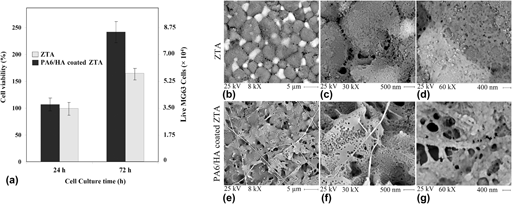Crossref Citations
This article has been cited by the following publications. This list is generated based on data provided by
Crossref.
Du, Zhiyun
Guo, Liying
Zheng, Tianyi
Cai, Qing
and
Yang, Xiaoping
2019.
Formation of core-shell structured calcium silicate fiber via sol-gel electrospinning and controlled calcination.
Ceramics International,
Vol. 45,
Issue. 18,
p.
23975.
EBRAHIMI, Adib
ESFAHANI, Hamid
IMANTALAB, Omid
and
FATTAH-ALHOSSEINI, Arash
2020.
Biological, antibacterial activities and electrochemical behavior of borided commercially pure titanium in BSA-containing PBS.
Transactions of Nonferrous Metals Society of China,
Vol. 30,
Issue. 4,
p.
944.
Yadi, Minoo
Esfahani, Hamid
Sheikhi, Mohsen
and
Mohammadi, Maryam
2020.
CaTiO3/α-TCP coatings on CP-Ti prepared via electrospinning and pulsed laser treatment for in-vitro bone tissue engineering.
Surface and Coatings Technology,
Vol. 401,
Issue. ,
p.
126256.
Chaharmahali, Razieh
Fattah-Alhosseini, Arash
and
Esfahani, Hamid
2020.
Increasing the in-vitro corrosion resistance of AZ31B-Mg alloy via coating with hydroxyapatite using plasma electrolytic oxidation.
Journal of Asian Ceramic Societies,
Vol. 8,
Issue. 1,
p.
39.
Yadi, Minoo
Esfahani, Hamid
Nourian, Alireza
Navard, Sahar Hamoon
and
Fattah-alhosseini, Arash
2021.
Surface modification of CP-Ti by calcium-phosphate via an integrated electrospinning and rapid heating and cooling (EMRHC) process: Essential in-vitro studies for bone regeneration.
Surfaces and Interfaces,
Vol. 27,
Issue. ,
p.
101480.
Sakthiabirami, Kumaresan
Soundharrajan, Vaiyapuri
Kang, Jin-Ho
Yang, Yunzhi Peter
and
Park, Sang-Won
2021.
Three-Dimensional Zirconia-Based Scaffolds for Load-Bearing Bone-Regeneration Applications: Prospects and Challenges.
Materials,
Vol. 14,
Issue. 12,
p.
3207.
Sowmya, S.
Mathivanan, Nirmal
Chandramouli, Arthi
and
Jayakumar, R.
2023.
Electrospun Polymeric Nanofibers.
Vol. 291,
Issue. ,
p.
191.
Shailaja, N.R.
Arulmozhi, M.
Balraj, B.
and
Siva, C.
2023.
Corallocarpus epigaeus mediated synthesis of ZnO/CuO integrated ZrO2 nanoparticles for enhanced in-vitro antibacterial, antifungal and antidiabetic activities.
Journal of the Indian Chemical Society,
Vol. 100,
Issue. 5,
p.
100991.
Xu, Yuhan
Wang, Jinheng
Wang, Zihao
Zhao, Yu
and
Guo, Weihong
2023.
Bio-based polyamide fibers prepared by mussel biomimetic modification of hydroxyapatite.
European Polymer Journal,
Vol. 187,
Issue. ,
p.
111913.
Gupta, Khanish
and
Meena, Kusum
2023.
Artificial bone scaffolds and bone joints by additive manufacturing: A review.
Bioprinting,
Vol. 31,
Issue. ,
p.
e00268.
Chakraborty, Urmila
Bhanjana, Gaurav
Kaur, Navneet
Kaur, Gurpreet
Kaushik, Ajeet Kumar
Kumar, Sandeep
and
Chaudhary, Ganga Ram
2023.
Engineered Nanostructures for Therapeutics and Biomedical Applications.
p.
227.
Shakiba, Mohamadreza
Sheikhi, Mehdi
Pahnavar, Zohreh
Tajiki, Alireza
Bigham, Ashkan
Foroozandeh, Amin
Darvishan, Sepehr
Pourmadadi, Mehrab
Emadi, Hamid
Rezatabar, Javad
Abdouss, Hamidreza
and
Abdouss, Majid
2023.
Development of an antibacterial and antioxidative nanofibrous membrane using curcumin-loaded halloysite nanotubes for smart wound healing: In vitro and in vivo studies.
International Journal of Pharmaceutics,
Vol. 642,
Issue. ,
p.
123207.
Hamedani, Khashayar Saei
Yadi, Minoo
and
Esfahani, Hamid
2024.
Influence of Residual Stress on Mechanical and Tribology Behaviors of Calcium-Phosphate Coating on Commercially Pure Titanium via Integrated Electrospinning and Rapid Heating and Cooling Process.
Journal of Materials Engineering and Performance,
Vol. 33,
Issue. 15,
p.
7689.
Foroozandeh, Amin
Shakiba, Mohamadreza
Zamani, Amirhosein
Tajiki, Alireza
Sheikhi, Mehdi
Pourmadadi, Mehrab
Pahnavar, Zohreh
Rahmani, Erfan
Aghababaei, Nafiseh
Amoli, Hossein Salar
and
Abdouss, Majid
2024.
Electrospun nylon 6/hyaluronic acid/chitosan bioactive nanofibrous composite as a potential antibacterial wound dressing.
Journal of Biomedical Materials Research Part B: Applied Biomaterials,
Vol. 112,
Issue. 1,
Afza, Saba
Esfahani, Hamid
Hassanzadeh Chinijani, Turan
and
Sharifi, Esmaeel
2025.
The role of BSA protein on the skin regeneration ability of electrospun PCL/HA scaffolds, kinetics of release and essential
in vitro
tests
.
The Journal of The Textile Institute,
Vol. 116,
Issue. 2,
p.
263.
